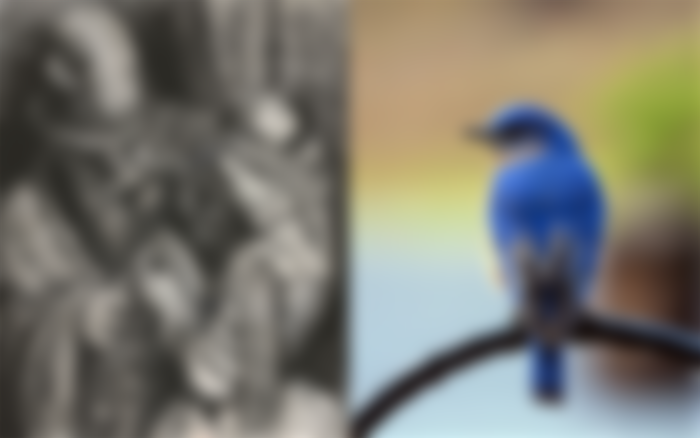Blue, Murdered Wives, Kings, and a Bird
What does the cruel Bluebeard, the murderer of many wives, have in common with a blue bird?
The “blue” of course, but there is more to it than that, the second common denominator is folktales; we will discuss two fairy-tales. A combination of two of my topics, literature and colour (although, admittedly, the importance of colour here is rather insignificant).

Barbe-Blue - Bluebeard
This is a fairy tale by Charles Perrault (1628-1703), which has been widely translated and spread, sometimes slightly changed. In English it is known under the name of Bluebeard.
Bluebeard was an ogre, who had been married many times. His last wife, the young Fatima, was trusted with all the keys of the castle, but was forbidden to unlock one particular room. Once in his absence, she nevertheless opened the forbidden room and found in it the dead bodies of his former wives. Betrayed by a bloodstain on the key, she was about to be put to death for her trespassing, but was saved by the arrival of her brothers, and Bluebeard was slain.
Charles Perrault more or less invented the fairy tale as we know it, and many internationally well-known tales originally were his, at least in the form we know them (although many of them has a much longer history). Apart from Barbe Bleue (Bluebeard), for instance Cendrillon (Cinderella), La Belle au bois dormant (Sleeping Beauty) and Le Petit Chaperon rouge (Little Red Riding Hood). Modern readers are most acquainted with most of these stories through an intermediary. namely the Brothers Grimm, whose collection of folk tales became normative, being the basis for later film interpretations by, for instance, Walt Disney (Snow White, Cinderella, etc...).
As for Bluebeard, a large number of authors have elaborated on the theme and various versions of the tale exist. The story has also inspired to music.
The word "ogre" means a monster who eats people, or sometimes a hideous and cruel man. This word (French: ogre) was probably coined by Charles Perrault.
Many fairy tales are based on, or a least inspired by, a true story from history. What about Bluebeard?
Well, we don't know for sure, but here are people who claim that the inspiration to Bluebeard is a 4th century Prince of Pohor, Conomor the Accursed, who married the widow of a king he had murdered in order to steal his kingdom. The widow was afraid of him, and managed to run away. Conomor, then a king, married St. Trephine, another woman. When she became pregnant, however, she feared he would kill her, because there was a prophesy that Conomor's own son would kill him. Thus she decided to make an attempt to escape. On her way she came to the royal crypt, where there were a number of coffins, each one, except last one, housing the corpse of a woman. The last one was empty, and believed to be for St. Trephine. Bluebeard eventually catches her and kills her. St.Gildas restores her to life, but when she is returned to Coromor, his castle collapses, and he dies. (The source of this story is a biography of St. Gildas.)
Another, often mentioned source of Bluebeard, is Breton serial killer Gilles de Rais. He, however, did not kill wives, but children, whom he allegedly abused sexually before murdering them. It is unclear however, if Gilles de Rais committed the crimes for which he was hanged and burned (they claimed he was a witch). In any case, he is an unlikely source of the story of Bluebeard.
L'oiseau Bleu – The Blue Bird
“L'oiseau bleu" (The Blue Bird) is a tale from "Contes Nouveaux ou les Fees a la Mode" by Marie Catherine le Jumelle de Barneville, Baronne d'Aulnoy (1650-1705), who in a way did introduce the fairy-tale into serious literature, and gave it its artistic form. She also invented the name: contes de fées (fairy tales).
L'oiseau blue is about prince Charming, who, in shape of a bird, is visiting princess Florine in a tower, but is injured by poisoned knives the princess' stepmother had placed outside the window. After that the princess found him and cured him. This, of course, is an extreme summary, the tale is far more detailed.
Incidentally, it is striking how consistently step-mothers are described in fairy-tales as bad and evil women!
Blue
So, what does the blue colour mean in this context?
In Bluebeard it is very simple. The man is described as having beard so black that it was blue.
In L'oiseau bleu, it is harder to say. Perhaps it has to do with blue as a symbol for “longing” & desire.
Resources:
Blue Beard (In English), from Andrew Lang, The Blue Fairy Book (London: Longmans, Green, and Company, ca. 1889), pp. 290-295.
La Barbe bleüe, édition de 1697 originale. (In French)
"The Blue Bird" in “Fairy Tales” by the Countess d'Aulnoy (1856). Translated to English by James Robinson Planché.
A website with some fairy-tales by Charles Perrault in French original.
Copyright © 2022 Meleonymica/Mictorrani. All Rights Reserved.
(Thumbnail & illustration: Left, Bluebeard, Woodcut by Gustave Doré, Public Domain - Right, Bluebird, photo by Shirley Dawson/Pixabay, CC0/Public Domain.)
Here you can find my articles about History of Literature.
Interested in history, legends and myths, join my community History, Myths, Legends & Mysteries (be45).
You find all my writings on Read.Cash, sorted by topic, here.
My 5 most recent articles:
Retrospection 14 (Health & Illness, and how we perceive them. Health Paradigms)
Bitcoin: Trustlessness & Backing

hello can you support me